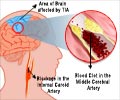A new research has found that countries which spend proportionately less money on health suffer from more stroke and stroke-related deaths.

Regardless of overall wealth, countries that spend less money proportionately on health care also had higher incidences of all four outcomes.
"Not only is the economic wellness of a country important, but also significant is what proportion of their gross domestic product is expended on health," said Luciano A. Sposato, M.D., M.B.A., study lead author and director of the neurology department at the Vascular Research Institute at INECO Foundation in Buenos Aires, Argentina. "This is very important for developing healthcare strategies to prevent stroke and other cardiovascular diseases."
In the large-scale literature review, researchers took a unique approach to identify stroke risk by correlating it to nationwide socioeconomic status.
Previous research tended to focus on the link between stroke and individual or family financial standing, said Sposato, also director of the Stroke Center at the Institute of Neurosciences, University Hospital Favaloro Foundation.
The study linked lower gross domestic product to:
- 32 percent higher risk of strokes;
- 43 percent increase of post-stroke deaths at 30 days;
- 43 percent increase in hemorrhagic stroke; and
- 47 percent higher incidence of younger-age-onset stroke.
Advertisement
- 26 percent higher risk of strokes;
- 45 percent increase of post-stroke deaths at 30 days;
- 32 percent increase in hemorrhagic stroke;
- 36 percent higher incidence of younger-age-onset stroke.
Investigators analyzed 30 population-based studies conducted between 1998 and 2008 in 22 countries. They used statistical methods to link stroke risk, 30-day death rate, hemorrhagic stroke incidence and age at disease onset to three internationally accepted economic indicators. The indicators included gross domestic product, health expenditure per capita and unemployment rate. Unlike the other two indicators, unemployment rate didn't affect stroke or other outcomes.
Advertisement
Stroke is the fourth leading cause of death in the United States and a major cause of long-term disability. Worldwide, stroke is the second leading killer.
Source-Eurekalert















